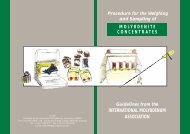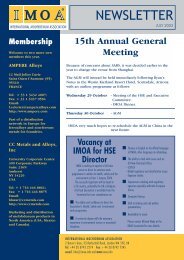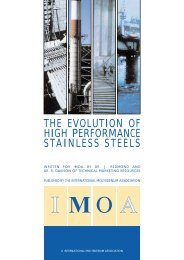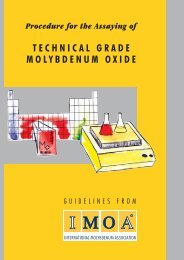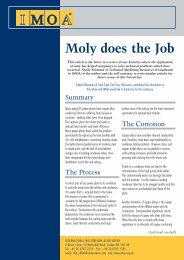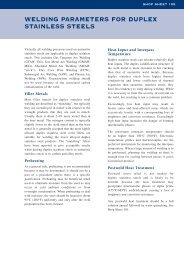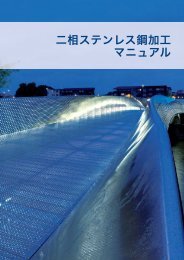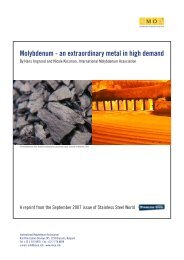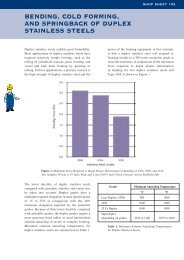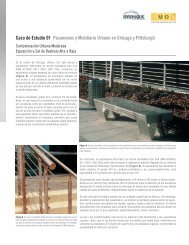2001 - IMOA
2001 - IMOA
2001 - IMOA
You also want an ePaper? Increase the reach of your titles
YUMPU automatically turns print PDFs into web optimized ePapers that Google loves.
NEWSLETTER<br />
13th<br />
Annual<br />
General<br />
Meeting<br />
At the kind invitation of AvestaPolarit,<br />
the AGM will be held in the Nordic Hotel,<br />
Stockholm with a provisional programme<br />
as follows:<br />
Wednesday, 12 September<br />
Cocktails and dinner in the hotel, hosted<br />
by <strong>IMOA</strong><br />
Thursday, 13 September<br />
13th AGM. Dinner hosted by<br />
AvestaPolarit at a restaurant<br />
in the archipelago<br />
Friday, 14 September<br />
Work’s visit to AvestaPolarit<br />
Presentations at the AGM will include:<br />
- updates on <strong>IMOA</strong>’s activities (HSE work,<br />
market development, etc.)<br />
- presentation by Stuart Pettifor,<br />
President of Coil Products and Deputy<br />
CEO, AvestaPolarit.<br />
Topics he will cover will include:<br />
■ General industrial landscape<br />
■ State of stainless steel industry<br />
■ Our merger and potential synergies<br />
■ Outlook for the industry<br />
Summary<br />
Many aging US power plants have copper alloy<br />
condensers that are suffering from erosion or<br />
corrosion. Leaking tubes have to be plugged.<br />
This requires plant shut down and leads to<br />
reduced heat transfer and lower efficiency.<br />
Many power plants have solved the problem<br />
permanently by replacing the tube bundles with<br />
4 to 6% molybdenum- containing stainless steels.<br />
The better thermal performance of stainless steel<br />
re-tubed units, and the lack of unscheduled<br />
outages due to leaking condenser tubes, more<br />
than compensate for the initial design and<br />
installation cost of the new tubing.<br />
The Process<br />
A critical part of any power plant is its condenser.<br />
It cools the steam from the turbine and condenses<br />
it to water that is recycled back to the boiler.<br />
The amount of power that is generated is<br />
correlated to the temperature difference between<br />
the steam temperatures at the inlet and outlet of<br />
the turbine. To minimize the condensate<br />
temperature, the condenser must maximize the<br />
heat transfer between the cooling water and the<br />
steam. Good thermal conductivity and large<br />
INTERNATIONAL MOLYBDENUM ASSOCIATION<br />
2 Baron’s Gate, 33 Rothschild Road, London W4 5HT, UK<br />
Tel: +44 20 8742 2274 Fax: + 44 20 8742 7345<br />
email: ITIA_<strong>IMOA</strong>@compuserve.com web: www.imoa.org.uk<br />
JULY <strong>2001</strong><br />
Moly does the Job<br />
This article is the latest in a series of case histories where the application<br />
of moly has helped companies to solve technical problems which have<br />
occurred. Nicole Kinsman of Technical Marketing Resources (Consultants<br />
to <strong>IMOA</strong>) is the author and she will continue to write similar articles for<br />
future issues of this Newsletter.<br />
Edward Blessman of Trent Tube, East Troy, Wisconsin, contributed the information in<br />
this article and <strong>IMOA</strong> would like to thank him for his assistance.<br />
surface area of the tubing are the most important<br />
parameters for optimal heat transfer.<br />
The Corrosion<br />
Copper alloys have excellent thermal conductivity<br />
and, therefore, have been used traditionally as<br />
condenser tubing material. However, brass and<br />
copper-nickel alloys are susceptible to erosion,<br />
sulfur pitting corrosion, and both ammonia<br />
grooving and cracking from the steam side.<br />
A leak in a condenser tube can lead to the<br />
contamination of the high purity boiler water.<br />
This contaminated water can damage the boiler<br />
and the turbines. For this reason a leaking<br />
condenser tube has to be plugged quickly and this<br />
may require an unscheduled shut down of the<br />
plant.<br />
Another limitation of copper alloys is the copper<br />
contamination of the effluent water and the<br />
condensate. Environmental regulations strictly<br />
limit the release of copper into lakes and rivers.<br />
Often the only way to comply with these<br />
regulations is to eliminate all copper-containing<br />
(Continued overleaf)
Moly does the job<br />
2<br />
alloys from the heat exchanger tubing. Copper<br />
in the condensate can also deposit in the boiler<br />
or the turbine and cause damage to the<br />
equipment.<br />
The Solution<br />
Stainless steel condenser tubing solves all of<br />
these problems. There have been more than<br />
35 million meters (almost 115 million feet) of<br />
stainless steel (all grades) condenser tubing<br />
installed in the US in the last five years (an<br />
average condenser may use 100,000 meters, a<br />
large nuclear power plant condenser can use up<br />
to 1 million meters). Over 3.5 million meters<br />
(11.5 million feet) were high performance 4 to<br />
6% molybdenum stainless steels. Traditionally<br />
the 6% Mo high performance austenitic grades<br />
were the most common, but in recent years an<br />
increasing number of plants have specified the<br />
4% Mo super ferritic grades because of cost<br />
advantages. Six major plants have re-tubed<br />
with high performance ferritics in the last two<br />
years, and many more are in the planning<br />
stages for the next few years.<br />
The ferritic stainless steels are especially well<br />
suited for re-tubing of copper alloy condensers<br />
due to their unique combination of properties.<br />
Copper tubing typically has a heavy wall<br />
Figure 1:<br />
Close-up of the tube<br />
sheet during installation<br />
of replacement tubing.<br />
thickness [0.049 inch (1.25 mm)] to<br />
compensate for its relatively low strength, low<br />
modulus of elasticity and its susceptibility to<br />
erosion. The better mechanical properties of<br />
high performance ferritic stainless steels allow<br />
the use of the same condenser designs with<br />
walls as thin as 0.028 inches (0.7 mm). The<br />
good heat transfer of the ferritics ensures that<br />
the thermal performance of the condenser<br />
remains high. Long-term thermal performance<br />
is enhanced compared to copper alloys, because<br />
the very smooth surface of stainless steel<br />
tubing minimizes fouling and remains cleaner.<br />
The high performance stainless steels are also<br />
resistant to erosion. When plant design will<br />
permit, it is advantageous to increase the<br />
cooling water flow velocity. The higher velocity<br />
increases heat transfer and improves the<br />
clean liness of the condenser.Higher flow rates<br />
are among the most economical methods to<br />
improve condenser performance.<br />
Stainless steels easily tolerate velocities of<br />
5 m/sec (16.4 feet/sec) without erosion.<br />
Most of the units re-tubed with high<br />
performance ferritics and austenitics are cooled<br />
by brackish or sea-water. These grades were<br />
chosen because of their high chloride resistance.<br />
There are also many fresh water-cooled units<br />
that could be re-tubed with standard austenitic<br />
stainless steels such as Type 304 or 316.<br />
However, their plant owners selected high<br />
performance ferritics instead. This "over-design"<br />
ensures reliability in case of upset conditions or<br />
future changes in the water chemistry, and helps<br />
to insure against forced outages because of<br />
condenser leaks.<br />
The Cost Savings<br />
The reasons driving power plants to upgrade<br />
condensers are improved reliability<br />
and profitability, and compliance with<br />
environmental regulations.<br />
The trend toward high Mo stainless steels has<br />
accelerated with the transition toward an open<br />
electricity market in the US. Power plants now<br />
compete for business, and if their costs are low<br />
enough, they can sell all of the power that they<br />
can generate.<br />
The most efficient power plants can generate<br />
power for less than $20 per MWhr. On the spot<br />
market, at times of peak demand, for example<br />
on a hot summer afternoon when air<br />
conditioners are running, power prices can be<br />
over $500 per MWhr. If a plant is off–line<br />
during a time of peak demand, it loses the<br />
opportunity to sell surplus power and it is forced<br />
to buy replacement power. For example, if a<br />
300 MW plant shuts down for 10 hours to plug<br />
leaking tubes, it loses 3,000 MWhr of<br />
generation capacity. This power costs as little<br />
as $60,000 to generate, but, it may cost as<br />
much as $1,500,000 to purchase the<br />
replacement power from another plant.<br />
Many older plants have a significant number of<br />
plugged condenser tubes. The leaks often stem<br />
from old ‘accidents’ and upsets. This reduction<br />
in heat transfer surface area may have a small<br />
effect on plant profitability during a time of low<br />
demand. However, any loss of heat transfer will<br />
hurt generating capacity most during hot<br />
weather, when the cooling water is warmer and<br />
does not have the same cooling capacity.<br />
Unfortunately, this is exactly when demand for<br />
power and its price are the highest.
Table 1:<br />
Typical Composition of High Performance Stainless Steels in Weight Percent<br />
UNS No. Cr Mo Ni<br />
Ferritics SEA-CURE ® S44660 27 4 2<br />
AL 29-4C ® S44735 29 4 0<br />
FS 10 ® S44800 29 4 2<br />
Austenitics AL-6XN ® N08367 21 6.5 24<br />
254 SMO ® S31254 20 6 18<br />
Table 2:<br />
Typical Properties of High Performance Stainless Steels<br />
UNS Thermal Modulus Yield Strength<br />
Conductivity [10 6 psi (GPa)] [ ksi (MPa) ]<br />
[Btu/ft hr °F<br />
(W/M °C)]<br />
Ferritics SEA-CURE ® S44660 9.5 (15.9) 31 (213) 75 (517)<br />
AL 29-4C ® S44735 9.5 (15.9) 31 (213) 80 (552)<br />
FS 10 ® S44800 9.5 (15.9) 31 (213) 85 (586)<br />
Austenitics AL-6XN ® N08367 7.5 (13) 28 (193) 55 (379)<br />
254 SMO ® S31254 7.9 (13.7) 29 (200) 50 (345)<br />
The 4% Mo ferritic and the 6% Mo austenitic high<br />
performance stainless steels are playing a<br />
significant role in improving the availability,<br />
reliability, capacity and economics of power plants<br />
in the US.<br />
Protected trademarks:<br />
SEA-CURE:<br />
Crucible Materials Corp.<br />
AL 29-4C and AL-6XN ATI Properties,Inc.<br />
FS-10:<br />
Sumitomo<br />
254 SMO: AvestaPolarit<br />
Readers with similar experiences,<br />
where moly has assisted in solving<br />
problems, are invited to contact the<br />
Secretariat.<br />
Congratulations to our Consultants, Technical Marketing<br />
Resources of Pittsburgh! The firm has been hired by the Johnson<br />
Space Centre to assist in the selection of materials (stainless<br />
steel) and surface finish for the tools and enclosures to hold the<br />
Mars rock and soil samples which will be brought to Earth as<br />
part of the Mars Surveyor 2005 project.<br />
3
<strong>IMOA</strong>’s Duplex Training Seminars –<br />
Success in the UK and Italy<br />
The Association’s appreciation and gratitude are due to all the sponsors, speakers, participants<br />
and planners who made the seminars so valuable in educational terms. Particular thanks,<br />
however, are due to Duncan Munro (Director of BSSA) and Fausto Capelli (Director of Centro<br />
Inox) for the fine planning, promotion and organisation of these highly successful events.<br />
These seminars are one-day workshops on the<br />
fabrication of duplex stainless steels which are<br />
increasingly regarded as at the leading edge of<br />
stainless steel applications development, due to<br />
their enhanced strengths and corrosion resistance.<br />
They offer a prime market opportunity for<br />
fabricators in the chemical, petro-chemical and<br />
pharmaceutical sectors, as well as in structural<br />
applications, such as reinforcement for bridges.<br />
Like all stainless steels, the duplex family is<br />
different, but not difficult to fabricate, once the<br />
basic principles of the material are understood.<br />
The workshops are designed to familiarise the<br />
audience with these basic principles and the<br />
advantages of fabricating duplex stainless steels.<br />
The workshops are primarily aimed at fabricators<br />
and sheet metalworkers, who have basic<br />
experience with working in stainless steels, and<br />
would like to familiarise themselves with duplex<br />
grades. The programme is also suitable for<br />
engineers, contractors, designers and specifiers,<br />
who are interested in the properties and<br />
application of duplex stainless steels.<br />
The workshops include the opportunity for<br />
discussion of case histories and for participants to<br />
ask questions, give comments and share their<br />
experience. Handouts, which include<br />
supplementary information as well as the<br />
material presented, are provided to each<br />
delegate.<br />
<strong>IMOA</strong>’s programme began in the USA in 2000<br />
and has continued to be a hit this year amongst<br />
European audiences in Germany, Italy and the<br />
UK; plans are already under review for venues in<br />
Asia.<br />
The latest seminars, conducted as usual by Nicole<br />
Kinsman (Technical Marketing Resources) and<br />
Heike Helfen (Climax Molybdenum) on <strong>IMOA</strong>’s<br />
behalf, began with a series of eight in the UK,<br />
spread during March and April this year and<br />
organized in cooperation with the British Stainless<br />
Steel Association (BSSA) with sponsorship from<br />
the Department of Trade and Industry and several<br />
local companies.<br />
Each seminar consisted of a brief introduction to<br />
the BSSA by its Director, Duncan Munro; an<br />
introduction to <strong>IMOA</strong> and discussion on why users<br />
choose duplex stainless steels by Heike Helfen;<br />
and the metallurgical basics of duplex stainless<br />
steels by Nicole Kinsman. After lunch, which was<br />
typically offered by the local sponsor, the<br />
presentations on welding and cutting, forming<br />
and machining were given by either a<br />
representative of the host or Nicole Kinsman.<br />
During this series, the format was modified to<br />
increase interaction between the presenters and<br />
the delegates. Discussions were conducted in<br />
small work-groups to give the participants more<br />
opportunity to think about what had been<br />
presented; to apply some of the theory to<br />
practical examples; and to raise concerns or<br />
questions regarding duplex stainless steel.<br />
The first seminar week was March<br />
26th to March 30th<br />
Leeds (hosted by AvestaPolarit)<br />
Birmingham (hosted by Sandvik)<br />
Pontypool, South Wales (hosted by AvestaPolarit)<br />
London (hosted by The Institute of Materials and<br />
NiDI).<br />
The second seminar week was April<br />
23th to April 27th<br />
Middlesborough (hosted by AvestaPolarit)<br />
Glasgow (hosted by TWI, Joining Forces North<br />
East)<br />
Belfast (no local host)<br />
Manchester (hosted by Weir Materials)<br />
The total number of participants in the two weeks<br />
of workshops was about 140 and special thanks<br />
are due to Chris Baxter of AvestaPolarit, Rex<br />
Withers of Sandvik Coromant, Dr. Liane Smith of<br />
the Nickel Development Institute (NiDI), Dr.<br />
Andrew Leonard of the Welding Institute (TWI),<br />
and Dr. Roger Francis of Weir Materials.<br />
The participants filled out feedback sheets and<br />
from these it seems that most people were very<br />
happy with the event and what they learned.<br />
<strong>IMOA</strong> and BSSA think that these workshops have<br />
made more people familiar with molybdenumcontaining<br />
duplex stainless steels and, in the long<br />
run, this will lead to increased specification and<br />
use of these grades.<br />
After a short respite, Heike and Nicole returned<br />
to Italy (a seminar had been given at the Duplex<br />
2000 Conference in Venice).<br />
Inspired by <strong>IMOA</strong>’s previous duplex seminars,<br />
Centro Inox (the Italian Stainless Steel<br />
Development Association) asked <strong>IMOA</strong> to<br />
co-operate in a joint seminar in Milan.<br />
The considerable increase in the use of stainless<br />
steel recorded in Italy, particularly in recent years,<br />
in all areas of applications, has led to extreme<br />
specialisation of end uses with increasingly<br />
advanced machining technologies and the search<br />
for materials with more specifications and high<br />
performances. To answer the needs of the various<br />
applications, new steels have been developed and<br />
among them duplex stainless steels.<br />
4
<strong>IMOA</strong>’s previous experience and the Centro<br />
Inox contacts with Italian specialists and its<br />
mailing list of fabricators, end-users and<br />
producers of stainless steel made for a great<br />
event with an excellent turnout. The all-day<br />
seminar took place on 29 May <strong>2001</strong> in the<br />
Centro Congressi Fondazione Stelline and<br />
featured speakers from various countries, all<br />
specialists in their respective fields. The<br />
Centro Inox promotional efforts attracted 140<br />
participants, of whom one-third were<br />
fabricators, one- third were stainless steel<br />
producers and the rest end-users, distributors<br />
and academics.<br />
Dr. Ing. Fausto Capelli, Director of Centro<br />
Inox, was the Chairman of the seminar.<br />
Heike Helfen introduced <strong>IMOA</strong> and covered<br />
the history and evolution of duplex stainless<br />
steels, whilst Nicole Kinsman talked about<br />
their metallurgy.<br />
Subsequent presentations related to<br />
machining, welding behaviour, resistance to<br />
corrosion and standards. Speakers included<br />
the following specialists: Giuliano Melotti<br />
(Acciaierie Valbruna) discussed fabrication;<br />
Giovanni Carratino (Italian Welding Institute)<br />
talked about welding; Professor Marco<br />
Boniardi (Technical University in Milan)<br />
covered corrosion resistance; Jan Olsson<br />
(AvestaPolarit) addressed standards and cost<br />
savings; and Omar Molinari (Ilta Inox),<br />
Robecco d’Oglio (CR), Mario Celant (MaC<br />
Materials and Corrosion) and Vizzolo<br />
Predabissi (MI) finished the proceedings with<br />
a discussion on their practical experiences.<br />
There was simultaneous translation in Italian<br />
and English and, at the end of the morning<br />
and afternoon sessions, the speakers<br />
answered questions in a podium discussion.<br />
The good turnout and the variety and quality<br />
of the questions indicate that the Italian<br />
market in general, and the attending<br />
audience in particular, are highly interested<br />
in using molybdenum-containing duplex<br />
stainless steels.<br />
LIFE CYCLE<br />
INVENTORY FOR<br />
MOLYBDENUM<br />
PRODUCTS<br />
Introduction<br />
Over the past 15 years, environmental issues<br />
have assumed an increasing priority for both<br />
government and industry alike. In North America<br />
as well as in Europe, the emphasis has gradually<br />
broadened from a site specific focus to include<br />
product attributes. Several regulations and<br />
schemes have been progressively implemented<br />
which address environmental issues regarding<br />
products. Similarly, product related<br />
environmental information is an increasing part of<br />
many companies’ decision-making process and is<br />
often shared with these companies’ customers.<br />
Life Cycle Assessment (LCA), and<br />
especially its most developed component, Life<br />
Cycle Inventory analysis (LCI), is a tool that<br />
provides quantitative and scientific analyses of the<br />
environmental impacts of products and their<br />
associated industrial systems. By providing an<br />
unbiased analysis of entire industrial systems,<br />
LCA has shown that the reality behind widely held<br />
beliefs regarding "green" issues is often more<br />
complex than expected.<br />
In 1998, the International Molybdenum<br />
Association (<strong>IMOA</strong>) commissioned Ecobalance to<br />
perform a Life Cycle Inventory (LCI) on three<br />
molybdenum products used in the metallurgical<br />
industry.<br />
Goal<br />
The aim of this study was to provide the<br />
Molybdenum Industry with a current LCI of three<br />
molybdenum products, using current, robust data<br />
on molybdenum production. The three products<br />
studied include:<br />
a. technical grade molybdic oxide<br />
(referred hereinafter as "tech oxide")<br />
in powder form;<br />
b.tech oxide in briquette form;<br />
c.ferromolybdenum in chip form.<br />
The LCI is "cradle to gate", i.e. from the point of<br />
extracting resources from the earth to the point<br />
where the molybdenum products are ready for<br />
shipment to customers. This LCI is based on<br />
current data on process technologies, energy and<br />
materials consumed, and environmental outputs.<br />
The LCI results may later be used by the<br />
molybdenum industry in the evaluation of the<br />
potential environmental impacts of molybdenum<br />
products and their applications. This data used<br />
with appropriate methodologies such as the ISO<br />
14000 standards can be the basis of industry<br />
benchmarking and management of environmental<br />
improvement programmes.<br />
The aim of this study is also to provide the<br />
stainless steel industry with LCI data for use in<br />
other LCI studies.<br />
The geographical scope of the study is worldwide<br />
production of molybdenum excluding China,<br />
Mongolia, and CIS (former USSR).<br />
This project adheres to the LCA guidelines<br />
summarised by ISO, which are widely<br />
acknowledged among the main practitioners in<br />
the US and in Europe. The requirements of this<br />
study are summarised in the following:<br />
■ ISO 14040:1997(E), the International<br />
Standard of the International Standardisation<br />
Organisation, Environmental management - Life<br />
cycle assessment - Principles and framework.<br />
5
Life Cycle Inventory for Molybdenum Products<br />
■ ISO 14041:1998(E), the International<br />
Standard of the International Standardisation<br />
Organisation, Environmental management -<br />
Life cycle assessment - Goal and scope definition<br />
and inventory analysis.<br />
The study aims to meet the essential<br />
requirements formalised by these ISO standards.<br />
Specifically,<br />
■ The project aims at taking an inventory of<br />
the environmental inflows and outflows<br />
associated with the cradle-to-gate production of<br />
a product;<br />
■ The goal and scope of the project are<br />
precisely defined at the beginning of the project;<br />
■ Assumptions are clearly stated, and the<br />
methodology is as transparent as allowed with<br />
the protection of confidential data.<br />
System boundaries, functional unit, and<br />
allocation rules are rigorously defined and<br />
described;<br />
■ Pertinent data are collected, and their<br />
quality is rigorously assessed;<br />
■ Reporting requirements are stated.<br />
Ecobalance worked to ensure that the major<br />
LCI-related methodological decisions (allocation<br />
rules, etc.) were consistent with the EUROFER<br />
and other stainless steel-related LCI studies to<br />
the extent that the confidentiality of all studies<br />
has been respected.<br />
This LCI will be the most comprehensive, current<br />
record of environmental inflows and outflows<br />
associated with molybdenum production.<br />
However, it should be borne in mind that this<br />
LCI, like any other scientific/quantitative study, is<br />
not completely free of some margin of error due<br />
to various limitations such as unavailability of<br />
some relevant data.<br />
Scope & Methodology<br />
Life Cycle Assessment (LCA) is an analytical tool<br />
used to comprehensively quantify and interpret<br />
the environmental flows (to and from the<br />
environment, including air emissions, water<br />
effluents, solid waste, and the<br />
consumption/depletion of energy and other<br />
resources), over the entire life cycle of a product<br />
or process. The life cycle assessment is a<br />
comprehensive study of a product which includes<br />
the production and extraction of raw materials,<br />
the manufacture of intermediate products,<br />
transportation, distribution, use, and a final<br />
"end-of-life" stage which often includes multiple<br />
parallel paths such as recycling, incineration,<br />
landfilling, etc.<br />
The three products included in the study are<br />
technical grade oxide in powder form and in<br />
briquette form; and ferromolybdenum. Nineteen<br />
sites including primary and by-product mines,<br />
and conversion facilities, participated in the<br />
study. Technical grade oxide and<br />
ferromolybdenum production represent some<br />
67% and 53% respectively of total Western<br />
world production.<br />
Companies in Europe and the Americas were<br />
well represented and a typical range of operating<br />
configurations included. This level of coverage<br />
makes <strong>IMOA</strong>’s LCI study one of the most<br />
representative LCI studies ever carried out for a<br />
material and this provides a sound basis for LCA<br />
studies relating to molybdenum.<br />
An LCA involves three main phases:<br />
1.Life Cycle Inventory Analysis is the "phase of<br />
the LCA involving the compilation and<br />
quantification of inputs and outputs, for a given<br />
product system throughout its life cycle." (ISO<br />
14040:1997(E), Section 3). This phase<br />
includes:<br />
■ defining the project system boundaries (i.e.<br />
defining which steps are included in the system<br />
and which are not) as specified by the goal and<br />
scope of the project;<br />
■ collecting data required for each step<br />
included in the system;<br />
■ calculating the final inventory.<br />
The compiled flows result in an inventory<br />
which is classified into five main categories: raw<br />
material consumption, energy consumption, air<br />
emissions, water effluents and solid waste.<br />
2.The Life Cycle Impact Assessment is the<br />
part of the LCA "aimed at understanding and<br />
evaluating the magnitude and significance of the<br />
potential environmental impacts of a product<br />
system" (ISO 14040:1997(E), Section 3).<br />
Examples of potential environmental impacts<br />
include natural resources depletion, global<br />
warming potential, and eutrophication potential.<br />
3.The Life Cycle Interpretation is the LCA step<br />
in which the "findings of either the inventory<br />
analysis or the impact assessment, or both, are<br />
combined in line with the defined goal and<br />
scope in order to reach conclusions and<br />
recommendations" (ISO 14040:1997(E),<br />
Section 3). With the exception of discussion of<br />
the results, that portion of an LCA was not<br />
performed.<br />
ISO’s representation of LCA actually indicates a<br />
four stage process, with Goal and Scope<br />
Definition preceding the Inventory Analysis<br />
phase. Individualising Goal and Scope Definition<br />
as a separate stage is not a key methodological<br />
issue, but was specially intended as a reminder<br />
that the key project objective parameters should<br />
be carefully established and clearly stated at the<br />
outset of an LCA, and that they guide the<br />
subsequent stages. All stages of an LCA should<br />
be scoped by the particular use or uses for which<br />
the study is intended, and that use of the results<br />
may entail some results interpretation.<br />
erated a large, rigorous and<br />
6
Results<br />
The LCI results provide average cradle- to- gate<br />
data for all the energy and material inputs, air<br />
emissions, water effluents and solid wastes for<br />
each of the three molybdenum products studied.<br />
Data from facilities around the world were<br />
collected to represent the molybdenum industry.<br />
The molybdenum data included in the study<br />
represents 56% of the total molybdenum<br />
produced in the world and 72% of production<br />
excluding China, Mongolia and CIS.<br />
Additional information available includes the<br />
geographical location and number of sites<br />
contributing to the average, minimum, maximum<br />
and standard deviation for each LCI flow<br />
monitored.<br />
<strong>IMOA</strong> proposes to review and update the LCI data<br />
on a regular basis, to take account of expanding<br />
and improved monitoring procedures. Where<br />
possible this review will include the broadening of<br />
the geographical coverage and the number of<br />
participating companies.<br />
Availability of Data<br />
Applications for LCI data are to be made through<br />
<strong>IMOA</strong> which will designate an LCI manager from<br />
one of the participating companies, according to<br />
geographical location, to liaise with the applicant.<br />
The normal procedure is to complete a<br />
questionnaire describing the intended application<br />
of the data and to discuss this with that LCI<br />
Manager. This will help to ensure that the <strong>IMOA</strong><br />
methodology and results can be applied<br />
appropriately and will be compatible with the<br />
goals of the study.<br />
Conclusions<br />
The <strong>IMOA</strong> LCI study has generated a large,<br />
rigorous and representative database. The results<br />
can be used reliably to assist decision-making and<br />
for evaluating the performance of molybdenum<br />
products in the context of sustainable<br />
development.<br />
The results also provide the opportunity for<br />
companies to benchmark and evaluate<br />
improvement measures to their processes and<br />
product systems.<br />
Industry expertise has been enhanced by<br />
involvement in the study and the industry is now<br />
better equipped to provide technical support to<br />
customers and users of molybdenum on LCA<br />
issues.<br />
A programme has been launched to keep the<br />
database up to date and further enhance the<br />
methodology and understanding of the study.<br />
Recommendations for improvement concerning<br />
both the documentation and the data will be<br />
welcome.<br />
For LCA to be used as a reliable tool for<br />
decision-making, high quality data, sound<br />
methodology and transparent reporting are<br />
essential. This study is a major step towards<br />
enhancement of these standards and the<br />
molybdenum industry intends to continue and<br />
encourage this trend in its future programme of<br />
work.<br />
Acknowledgement<br />
<strong>IMOA</strong> wishes to acknowledge with thanks<br />
the help of the International Iron & Steel<br />
Institute (IISI). This summary, the policy and<br />
communication guidelines, and the<br />
questionnaire are based on the format of the<br />
IISI’s own LCI for the steel industry; their<br />
permission to take advantage of their<br />
expertise is greatly appreciated.<br />
The second edition of this<br />
brochure is ready to go to the<br />
printers. Readers wanting copies<br />
of the revised brochure are<br />
invited to email the Secretariat,<br />
specifying numbers and full<br />
mailing address.<br />
Membership<br />
<strong>IMOA</strong> welcomes the membership<br />
of:<br />
Jiangsu Fengfeng Tungsten &<br />
Molybdenum Products Co., Ltd<br />
Tang Jia Se, The Northern Suburbs<br />
of Dongtai, Jiangsu, CHINA<br />
Tel: + 86 515 523 1237<br />
Fax: + 86 515 523 5949<br />
E-mail: dmcp@public.yc.js.cn<br />
Produces molybdic trioxide,<br />
ammonium molybdate,<br />
Mo powders,<br />
bars and plate blanks<br />
7
LIST of MEMBERS<br />
Secretary-General:Michael Maby<br />
AUSTRIA<br />
Interalloys Trading & Business Consulting GmbH<br />
A-1040 Vienna, AUSTRIA<br />
Tel: + 43 1 504 6138; Fax: + 43 1 504 6192<br />
E-mail: interal@ycn.com<br />
Treibacher Industrie AG<br />
A-9330 Althofen, AUSTRIA<br />
Tel: + 43 4262 5050; Fax: + 43 4262 2813<br />
E-mail: tam@treibacher.at http://www.treibacher.at/<br />
BELGIUM<br />
ALZ NV<br />
Genk-Zuid: Zone 6A, B-3600 Genk, BELGIUM<br />
Tel: + 32 89 302 401; Fax: + 32 89 302 106<br />
E-mail: info@alz.bc http://www.alz.be<br />
Sadaci NV<br />
Langerbruggekaai 13, B-9000 Gent, BELGIUM.<br />
Tel: + 32 92 540 511; Fax: + 32 92 540 571<br />
E-mail: msmeets@sadaci.be<br />
CANADA<br />
Highland Valley Copper<br />
Suite 400 – Oceanic Plaza,1066 West Hastings Street<br />
Vancouver BC V6E 3X1, CANADA<br />
Tel: +1 604 688 2211; Fax: +1 604 688 0646<br />
E-mail: greynard@hvcopper.com<br />
CHILE<br />
Codelco Chile<br />
Huerfanos 1270, Santiago, CHILE<br />
Tel: + 56 2 690 3406; Fax: + 56 2 690 3366<br />
E-mail: jleibbra@stgo.codelco.cl<br />
Molibdenos y Metales S.A.<br />
Huerfanos 812, 6th Floor, Santiago, CHILE<br />
Tel: + 56 2 368 3600; Fax: + 56 2 633 4429<br />
E-mail: info@molymet.cl http://www.molymet.cl/<br />
CHINA<br />
China Molybdenum Producers Association<br />
Room 301, Sino Intellectual Business<br />
No.1 South Section, Huan Cheng East Road Xian, Shaanxi, PR CHINA 710048<br />
Tel: + 86 29 249 5429; Fax: + 86 29 249 4173<br />
E-mail: chinamlt@china.com<br />
Jiangsu Fengfeng Tungsten & Molybdenum Products Co., Ltd<br />
Tang Jia Se, The Northern Suburbs of Dongtai, Jiangsu, CHINA<br />
Tel: + 86 515 523 1237; Fax: + 86 515 523 5949<br />
E-mail: dmcp@public.yc.js.cn<br />
Liaoning Chaoyang Dongfeng Ferroalloy Plant<br />
8 Nanda Street, Chaoyang, Liaoning, 122000, P R CHINA<br />
Tel: + 86 421 261 7887<br />
Fax: + 86 421 261 7997<br />
E-mail: cymoly@mail.cyptt.In.cn<br />
Linghai Sing Horn Enterprise Co., Ltd<br />
No.56, Shangdali, Taihe District, Jinzhou Liaoning, CHINA<br />
Tel: + 86 416 517 1930; Fax: + 86 416 517 1944<br />
E-mail: jzlhshs@mail.jzptt.ln.cn http://www.singhorn.com/<br />
Sinomoly Ltd<br />
Unit 3101, Office Tower, Convention Plaza ,<br />
1 Harbour Road, Wanchai, Hong Kong , CHINA<br />
Tel: + 852 2588 1858; Fax: + 852 2588 1545<br />
E-mail: jdcmoly@sinomoly.com.hk<br />
GERMANY<br />
F W Hempel Metallurgical GmbH<br />
Leopoldstr. 16, D-40211 Düsseldorf GERMANY<br />
Tel: + 49 211 168 060; Fax: + 49 211 168 0644<br />
E-mail: info@fwhempel.de http://www.fwhempel.de/<br />
Metherma GmbH<br />
Arnheimer Str. 103<br />
D-40489 Düsseldorf, GERMANY<br />
Tel: + 49 211 40 80 840; Fax: + 49 211 40 71 26<br />
E-mail: metherma.molybdenum@t-online.de<br />
H C Starck GmbH & Co KG<br />
Im Schleeke 78 - 91, Postfach 25 40, D-38615 Goslar, GERMANY<br />
Tel: + 49 5321 751 0; Fax: + 49 5321 751 192<br />
E-mail: georg.nietfeld.gn@hcstarck.de http://www.hcstarck.com/<br />
ITALY<br />
Gerli Metalli SpA<br />
Piazza S. Maria Beltrade 1, I-20123 Milan ITALY<br />
Tel: + 39 02 809 511; Fax: + 39 02 890 0714<br />
E-mail: gerlimetalli@mail.mdsnet.it<br />
Italchimici SpA<br />
Via M. D’Azeglio 62, I-25067 Lumezzane ITALY<br />
Tel: + 39 030 892 2255; Fax: + 39 030 892 0661<br />
E-mail: italchim@lumetel.it<br />
JAPAN<br />
Kohsei Co., Ltd<br />
Marukashiwa Building, 6F 1-6-1 Honcho Nihonbashi Chuo-ku<br />
103-0023 Tokyo, JAPAN<br />
Tel: + 81 3 3270 0303; Fax: + 81 3 3270 7504<br />
E-mail: furuta@kohsei.co.jp<br />
Nissho Iwai Corp<br />
Tradepia Odaiba, 3-1, Daiba 2-chome, Minato-ku, Tokyo 135-8655, JAPAN<br />
Tel: + 81 3 5520 3529; Fax: + 81 3 5520 3517<br />
E-mail: matsumura.hiroshi@nisshoiwai.co.jp<br />
Taiyo Koko Co., Ltd<br />
3-1, 3-chome Marunouchi, Chiyoda-ku, Tokyo 100-0005, JAPAN.<br />
Tel: + 81 3 3216 6041; Fax: + 81 3 3216 6045<br />
E-mail: trade@taiyokoko.co.jp<br />
LUXEMBOURG<br />
Considar Europe SA<br />
3 rue Pletzer, Centre Helfent, L-8080 Bertrange LUXEMBOURG.<br />
Tel: + 352 45 99 99 1<br />
Fax: + 352 45 99 99 223<br />
E-mail: heinz.duechting@considar.lu<br />
MEXICO<br />
Mexicana de Cobre SA de CV<br />
Av. Baja California 200, Col. Roma Sur, 06760 Mexico DF, MEXICO<br />
Tel: + 52 5 264 7775; Fax: + 52 5 264 7769<br />
E-mail: adenekeng@gmexico.com.mx http://www.gmexico.com/<br />
PERU<br />
Southern Peru Copper Corporation<br />
Av. Caminos del Inca 171,Chacarilla del Estanque, Surco, Lima 33, PERU<br />
Tel: + 51 1 372 1414; Fax: + 51 1 372 0237<br />
E-mail: jdlheros@southernperu.com.pe http://www.southernperu.com/<br />
SWEDEN<br />
AvestaPolarit Oyj Abp<br />
S-774 80 Avesta, SWEDEN<br />
Tel: + 46 226 810 00; Fax: + 46 226 813 05<br />
E-mail: marie.louise.falkland@avestapolarit.com<br />
Scandinavian Steel AB<br />
Birger Jarlsgatan 15, SE 111 45 Stockholm, SWEDEN<br />
Tel: + 46 8 614 2850; Fax: + 46 8 611 6434<br />
E-mail: metals@scandinaviansteel.se<br />
SWITZERLAND<br />
Glencore International AG<br />
Baarermattstrasse 3, P O Box 555, CH-6341 Baar, SWITZERLAND<br />
Tel: + 41 41 709 2000; Fax: + 41 41 709 3000<br />
E-mail: isaac.levy@ch.glencore.com<br />
UK<br />
Adams Metals Ltd<br />
Norwich House, 14 North Street , Guildford, Surrey GU1 4AF, UK<br />
Tel: + 44 1483 577900; Fax: + 44 1483 578008<br />
Toll Free/ USA– Tel: +1 800 473 8427; Fax: +1 800 473 8428<br />
E-mail: adamsmetals@btinternet.com http://www.adamsmetals.com/<br />
Brandeis Ltd<br />
Pechiney House, The Grove, Slough, Berkshire SL1 1QF<br />
Tel: +44 1753 522 800; Fax: +44 1753 825 033<br />
E-mail: Christian_Masson-Brandeis@Pechiney.com<br />
Eastlink Ferro Alloys Ltd<br />
Surrey Street, Glossop, Derbyshire SK13 7AL UK<br />
Tel: + 44 1457 852333; Fax: + 44 1457 855655<br />
E-mail: david.l@eastlinklanker.com<br />
Alfred H Knight International Ltd<br />
Eccleston Grange, Prescot Road, St Helens, Merseyside WA10 3BQ, UK<br />
Tel: + 44 1744 733757; Fax: + 44 1744 27062<br />
E-mail: st-helens@alfred-h-knight.co.uk<br />
Derek Raphael & Co Ltd<br />
2nd Floor, 6 York Street, London W1U 6PL, UK<br />
Tel: + 44 20 7535 1690; Fax: + 44 20 7535 1691<br />
E-mail: DRaphael@derek-raphael.co.uk http://www.derek-raphael.co.uk/<br />
Alex Stewart (Assayers) Ltd<br />
Caddick Road, Knowsley Industrial Estate Merseyside LL34 9ER, UK.<br />
Tel: + 44 151 548 7777; Fax: + 44 151 548 0714<br />
E-mail: enquiries@ alexstewart.com<br />
Wogen Resources Ltd<br />
4 The Sanctuary, Westminster, London SW1P 3JS, UK.<br />
Tel: + 44 20 7222 2171; Fax: + 44 20 7222 5862<br />
E-mail: akerr@wogen.co.uk http://www.wogen.com/<br />
USA<br />
Alldyne Powder Technologies<br />
7300 Hiway 20 WestHuntsville, Ala 35806, USA<br />
Tel: + 1 256 837 1311; Fax: 1 256 722 2283<br />
E-mail: jjohnson@alldyne.com<br />
American Flux & Metal<br />
P O Box 74 - Fleming Pike, Winslow, NJ 08095, USA<br />
Tel: + 1 609 561 7500; Fax: + 1 609 561 3724<br />
E-mail: flux@bellatlantic.net http://www.americanflux.thomasregister.com/<br />
The Chem-Met Co<br />
P O Box 819, Clinton, MD 20735-0819, USA<br />
Tel: + 1 301 868 3355; Fax: + 1 301 868 8946<br />
E-mail: afox@chem-metco.com<br />
Climax Molybdenum Company<br />
1501 West Fountainhead Parkway,P O Box 22015, Tempe, AZ 85285-2015, USA<br />
Tel: + 1 602 929 4400; Fax: + 1 602 929 4410<br />
E-mail: dthornton@phelpsdodge.com<br />
Comsup Commodities Inc<br />
1 Bridge Plaza North, Fort Lee, NJ 07024, USA<br />
Tel: + 1 201 947 9400; Fax: + 1 201 461 7577<br />
E-mail: comsup@earthlink.net<br />
Kennecott Utah Copper Corp<br />
8315 West 3595 South, P O Box 6001, Magna Utah 84044-6001, USA<br />
Tel: + 1 801 252 3000; Fax: + 1 801 252 3292<br />
E-mail: sullivas@kennecott.com<br />
Molycorp Inc<br />
376 S. Valencia Avenue, Brea, California 92823, USA<br />
Tel: + 1 714 577 1757 ; Fax: + 1 714 577 2779<br />
E-mail: cjcynor@unocal.com<br />
Osram Sylvania Products Inc<br />
Hawes Street, Towanda, PA 18848, USA.<br />
Tel: + 1 570 268 5000; Fax: + 1 570 268 5113<br />
E-mail: susan.dunn@sylvania.com<br />
Powmet Inc<br />
P O Box 5086, 2625 Sewell Street, Rockford, IL 61125, USA.<br />
Tel: + 1 815 398 6900; Fax: + 1 815 398 6907<br />
E-mail: wct@powmet.com<br />
H. C. Starck<br />
21801 Tungsten Road, Cleveland, Ohio 44117, USA<br />
Tel: + 1 216 692 4452; Fax: + 1 216 692 0031<br />
E-mail: jcdurham@worldnet.att.net<br />
Thompson Creek Metal Company<br />
945 West Kenyon Avenue, Englewood, CO 80110-3469, USA<br />
Tel: + 1 303 761 8801; Fax: + 1 303 761 7420<br />
E-mail: marionc@tcrk.com



